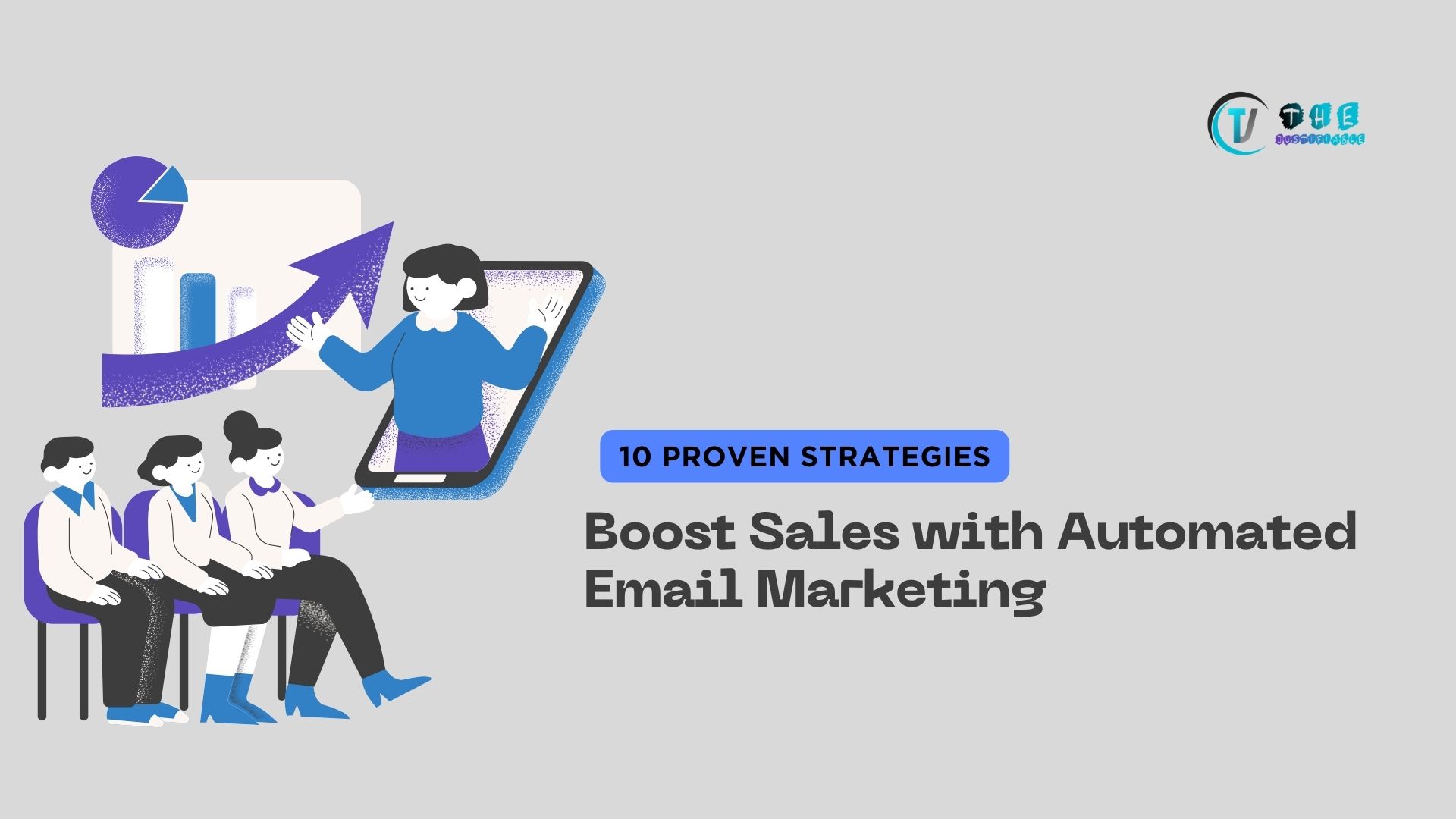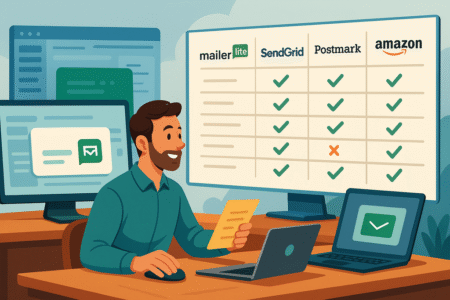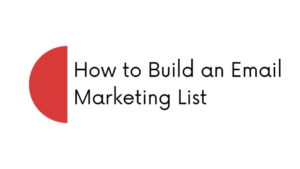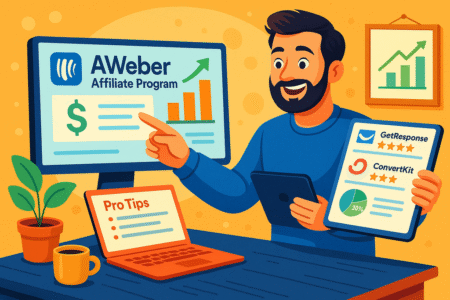Table of Contents
Aweber alternatives are on the radar for many creators, entrepreneurs, and small businesses in 2025. Is Aweber really the best option for your budget anymore? Or are there platforms out there that offer smarter automation, better pricing, and tools more suited to the way you actually work?
With so many email marketing services now competing for attention, it can be tough to figure out which ones deliver real value without breaking the bank.
This guide explores the top contenders that not only cost less than Aweber but also bring stronger features to the table, helping you decide which platform truly fits your goals.
KIT (formerly ConvertKit): A Creator-Friendly Aweber Alternative
If you’re looking for aweber alternatives that truly understand creators, Kit is often the first platform worth exploring.
It’s designed specifically with bloggers, YouTubers, and course creators in mind — people who don’t want bloated corporate software but still need automation powerful enough to grow their audience.
Easy Automation For Email Sequences And Funnels
One of the standout advantages of Kit is how natural it feels to set up automations. Instead of wrestling with a complicated workflow builder, you get a clean visual map that shows exactly how your subscribers move through your funnel.
For example, if someone downloads your free guide, you can set up a trigger to send them a welcome sequence. Then, if they click on a specific link in email three, Kit can automatically tag them as “Interested in Product A” and move them into a tailored sales sequence.
You don’t have to be a tech wizard to do this — it’s literally a matter of selecting “Add Tag” or “Move Subscriber” in the automation editor.
I like that Kit keeps its options lean. You’re not drowning in a hundred unnecessary settings. Instead, you get just enough flexibility to personalize without overcomplicating things. That’s a big relief if you’ve ever felt overwhelmed inside more “all-in-one” platforms.
Pricing Tiers That Scale With Your Growth
Kit’s pricing is refreshingly aligned with how creators grow. The free plan covers up to 1,000 subscribers and already includes unlimited landing pages, forms, and even email broadcasts. That means you can start collecting leads without pulling out your credit card.
Once you scale past the free plan, pricing moves up based on your subscriber count — but here’s the kicker: you get access to automation even at lower tiers. Aweber locks many features behind higher-priced plans, while Kit includes them earlier.
For a creator who’s just starting to see traction, that can save hundreds over the course of a year.
Here’s a quick comparison for 5,000 subscribers:
It doesn’t sound massive on paper, but if you’re running lean, that difference adds up. Plus, the extra automation features ConvertKit throws in mean you’re getting more for less.
Why Bloggers And Creators Prefer ConvertKit
Kit was built with storytelling in mind. Unlike tools that bury you under enterprise-level features, Kit keeps its focus on helping creators nurture relationships. The text-based email approach feels more personal, which is exactly why open rates often outperform flashier platforms.
I’ve seen bloggers double their affiliate income just by moving to Kit because they were finally able to create automated “choose your own adventure” email paths.
A reader clicks a link about fitness, and suddenly, they’re nurtured through fitness content instead of generic newsletters. That kind of personalization is worth gold when your income depends on trust and attention.
If you’re a creator who values connection over complexity, Kit is one of the smartest aweber alternatives in 2025.
MailerLite: Affordable Yet Feature-Rich Choice
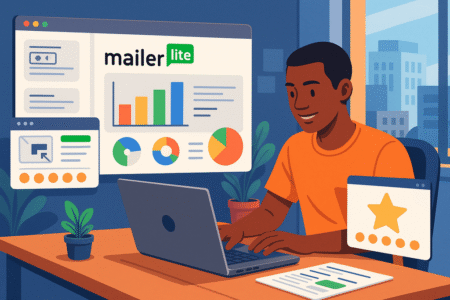
When affordability is the dealbreaker, MailerLite comes up strong as one of the most practical aweber alternatives. It’s simple, modern, and manages to pack in impressive features without feeling bloated.
For small businesses, startups, or solo marketers, MailerLite gives you the tools to compete without a heavy subscription bill.
Drag-And-Drop Editor For Beginners And Pros
MailerLite’s drag-and-drop editor is a dream for anyone who doesn’t want to wrestle with design software. You can literally start from a blank canvas, drag in blocks for text, images, buttons, and countdown timers, and build a polished email within minutes.
Unlike Aweber’s editor, which sometimes feels clunky and outdated, MailerLite’s UI feels smooth and intuitive. Want to add a product box for your store? Just drag it in. Need a survey block to ask your subscribers a quick question? Two clicks and it’s live.
If you’re more advanced, you’ll appreciate that you can switch to HTML editing whenever you need finer control. That balance between beginner-friendliness and pro-level flexibility is rare in this price bracket.
Cost Comparison Against Aweber’s Plans
This is where MailerLite really shines. For 1,000 subscribers, MailerLite’s free plan already gives you 12,000 emails per month, automation, and access to its website builder. Aweber’s free plan caps you at 500 subscribers and slaps branding on your emails.
Here’s a side-by-side for 10,000 subscribers:
- Aweber: Around $83.33/month
- MailerLite: Around $65.70/month
That’s nearly a 30% difference in monthly cost. Over a year, the savings can easily fund other parts of your business, like running ads or upgrading your hosting.
Advanced Segmentation Without The High Price
Segmentation — splitting your audience into meaningful groups — is usually a feature companies hide behind higher-priced tiers. MailerLite, though, makes it available upfront. You can tag subscribers based on clicks, signup source, or behavior, and then send highly relevant campaigns.
For example, if you run an online store, you can tag people who clicked “Shoes” on your last email and send them a targeted discount just for footwear. Or if you’re a blogger, you can create separate segments for people interested in “Travel” versus “Finance” content. That level of targeting is how small email lists punch above their weight in conversions.
I’ve noticed that businesses who switch from Aweber to MailerLite often comment on how much easier it is to actually use segmentation day-to-day. Aweber feels like you need a manual. MailerLite feels like you need five minutes.
For anyone balancing budget and usability, MailerLite is one of the most underrated aweber alternatives in 2025.
GetResponse: Powerful Marketing Beyond Email
If you’re searching for aweber alternatives that do more than just send emails, GetResponse deserves attention. It has evolved into a true marketing hub, combining email with landing pages, funnels, and even webinars.
For businesses that need a platform to handle multiple growth channels in one place, GetResponse is a serious contender.
Integrated Webinars And Funnels For Businesses
One of the most underrated features of GetResponse is its built-in webinar tool. Most platforms make you rely on Zoom or other third-party services, but here you can host live or on-demand webinars directly inside your email platform. From the dashboard, it’s as simple as going to “Tools > Webinars > Create Webinar.” You can set up registration pages, reminders, and follow-up sequences without needing extra software.
Pair this with their funnel builder, and you get an end-to-end sales pipeline. Imagine this:
- You run an ad promoting a free training.
- Leads register via a GetResponse landing page.
- They attend your webinar inside GetResponse.
- After the session, they automatically enter a sales funnel with nurturing emails.
Instead of piecing together five different services, GetResponse stitches it all into one smooth system. For mid-sized businesses, that efficiency is worth its weight in gold.
AI-Powered Tools For Smarter Campaigns
GetResponse has leaned into AI in ways Aweber simply hasn’t. Their AI subject line generator, for example, analyzes your email content and suggests subject lines that are statistically more likely to get opened. You don’t have to stare at a blank box wondering how to write something clickable.
Even more impressive is the “Perfect Timing” feature. Instead of blasting your list all at once, GetResponse calculates the best time to deliver each email based on when individual subscribers usually open. That tiny tweak often boosts open rates by 10–20% — a difference that compounds quickly when you’re sending to thousands of contacts.
I recommend testing this by running a split campaign: one with Perfect Timing on, one without. In my experience, the AI-powered delivery almost always outperforms manual scheduling.
Value For Mid-Sized Businesses Seeking Growth
GetResponse isn’t the cheapest tool on the market, but it’s built for businesses ready to scale. Their pricing starts competitively, but the real value appears once you consider the features you’d otherwise need to pay separate vendors for:
- Webinar hosting
- Funnel builder
- Landing pages
- Automation workflows
When you add those costs together, GetResponse actually ends up being less expensive than stitching together Aweber plus Zoom plus ClickFunnels. For a mid-sized business trying to consolidate tools, that’s not just convenience — it’s strategy.
If you’re serious about growth and want an aweber alternative that feels more like an all-in-one command center, GetResponse is worth a closer look.
Moosend: Budget-Friendly Option With Advanced Features
Moosend doesn’t always get the same spotlight as Kit or Mailchimp, but it’s one of the most underrated aweber alternatives in 2025. Think of it as the scrappy underdog that delivers surprising power at a fraction of the cost.
If you’re a startup, small team, or side hustler trying to stretch your marketing dollars, Moosend might be your perfect fit.
Robust Automation For A Fraction Of Aweber’s Cost
Moosend’s automation builder is impressive considering the price point. From the dashboard, click “Automations > New Automation” and you’ll see a visual workflow that lets you map out subscriber journeys with ease. Triggers include things like signing up for a form, clicking a link, or even browsing behavior if you integrate with your website.
For example, if someone adds a product to their cart but doesn’t check out, you can automatically send a three-email sequence:
- A reminder with the cart contents.
- A discount code if they still don’t buy.
- A “last chance” email to close the sale.
These kinds of automations are usually hidden behind premium tiers in other platforms, but Moosend includes them upfront — even in their lower-cost plans.
Built-In Analytics To Optimize Performance
Data-driven decisions are where Moosend shines. You don’t just see basic open and click rates; you get deeper insights into subscriber behavior. Heatmaps show exactly which parts of your email people interact with most, so you can tweak your design accordingly.
I suggest testing subject lines using their A/B split feature. For example, send half your list “10% Off Just For You” and the other half “Your Cart Misses You.” Moosend will track performance in real time and automatically declare a winner. This kind of practical feedback loop is invaluable when every email counts.
What I appreciate most is how clean the reporting dashboard looks. You don’t need to be a data analyst to understand what’s working — charts and metrics are laid out in a way that actually helps you act on the numbers.
Why Moosend Appeals To Startups And Small Teams
Price is the obvious hook. Moosend offers plans starting as low as $9/month for up to 500 subscribers, which undercuts Aweber by a wide margin. For teams running on tight budgets, that breathing room matters.
But beyond cost, it’s the simplicity that wins small teams over. The interface feels modern, the learning curve is shallow, and you don’t get lost in menus. You can onboard a new team member quickly without long training sessions.
I’ve seen small ecommerce shops thrive with Moosend simply because they could finally afford to set up proper automations without committing to a heavyweight tool. When every dollar matters, Moosend lets you play at a professional level without paying enterprise prices.
If you’re looking for aweber alternatives that pack automation and analytics into a lightweight, affordable package, Moosend is one of the smartest picks for 2025.
ActiveCampaign: Premium Alternative With Smarter CRM
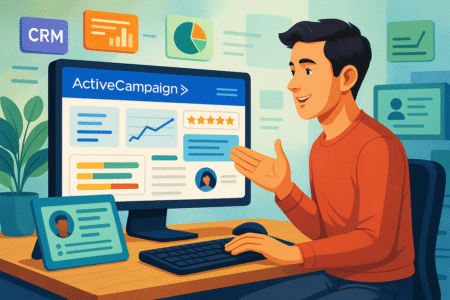
ActiveCampaign isn’t just another aweber alternative; it’s often considered the “grown-up” option for businesses that want deep customer insights paired with advanced automation.
If Aweber feels like a solid starter car, ActiveCampaign is more like upgrading to a fully loaded Tesla — smart, sleek, and always one step ahead.
Deep CRM Integration For Better Customer Journeys
One of the biggest advantages of ActiveCampaign is its built-in CRM (Customer Relationship Management). While Aweber keeps things simple with lists and tags, ActiveCampaign lets you manage leads and customers more holistically.
For example, from the dashboard, you can go to “Deals > Pipelines” and create a full sales pipeline that shows you exactly where each lead is in the buying process. If someone clicks a product link in your email but doesn’t purchase, you can set an automation to create a “deal” for that contact and assign it to a sales rep.
I like to think of it as a bridge between email marketing and sales. Instead of juggling two tools, you have one unified system where marketing hands off warm leads directly to sales — no spreadsheets required.
Advanced Personalization And Behavioral Targeting
ActiveCampaign takes personalization to another level. You can set up “if/then” logic inside emails that changes content based on who’s reading.
Here’s an example:
- Subscriber A browsed your website’s “shoes” section.
- Subscriber B browsed “jackets.”
- They both get the same email, but the main product image dynamically switches to match their browsing history.
That kind of personalization turns emails into one-to-one conversations rather than generic blasts. And when paired with behavioral targeting — like sending a follow-up only if someone watched a video or spent 30 seconds on a page — your campaigns become both smarter and less annoying to your audience.
Higher Cost Justified By Long-Term ROI
ActiveCampaign is not cheap, and I’ll be honest: if you’re a hobby blogger or just testing the waters, it may feel like overkill. Plans start higher than Aweber’s, and costs rise quickly as your list grows.
But for businesses already investing in growth, the return can be significant. Companies often see higher conversion rates because of the precision targeting and automation.
For example, one ecommerce brand I advised reduced abandoned cart losses by 20% in just two months after switching to ActiveCampaign’s behavior-driven automations.
If you’re ready to scale and want a tool that doubles as both an email platform and CRM, ActiveCampaign justifies the price by delivering measurable growth.
Brevo (Formerly Sendinblue): Flexible And Scalable Solution
Brevo, which you might remember as Sendinblue, is one of those aweber alternatives that quietly packs in more features than most people expect.
It’s built with flexibility in mind, making it a great choice for businesses that want to keep costs predictable while scaling across multiple marketing channels.
Pay-As-You-Go Pricing For Budget Control
One thing I love about Brevo is its pricing model. Unlike Aweber, which charges based on the number of subscribers, Brevo’s plans are based on how many emails you send. That means you’re not punished for having a big list — only for how much you use it.
This makes it perfect for businesses with a large database but lower send frequency. For instance, if you run a membership site and only email your audience twice a month, you’ll pay far less than you would with Aweber.
From the dashboard, you can even buy “email credits” instead of subscribing monthly. That flexibility is rare and can save you hundreds over time.
Multi-Channel Marketing Beyond Just Emails
Brevo isn’t just about email. It also integrates SMS, chat, and even WhatsApp messages into the same platform. That means you can create cross-channel campaigns where a subscriber might first receive an email, then get a reminder via SMS if they don’t open, and finally see a follow-up on WhatsApp.
Setting this up is simple. From the dashboard, go to “Campaigns > Create Campaign” and you’ll see options for email, SMS, and chat right there. The ability to manage everything in one place is a big time saver compared to juggling multiple tools.
For ecommerce stores, this is especially powerful. Imagine a customer abandoning a cart: they first get an email, then a text message reminder with a discount code. That layered approach increases the odds of recovering the sale.
Why Brevo Is Ideal For Ecommerce And Agencies
Ecommerce businesses love Brevo because it integrates tightly with platforms like Shopify, WooCommerce, and Magento. Agencies also appreciate it because you can manage multiple client accounts from a single dashboard.
The automation features aren’t quite as advanced as ActiveCampaign’s, but for the price, they’re more than enough. You can set up product-based triggers, segment customers by purchase history, and even run transactional emails alongside campaigns.
Brevo hits a sweet spot: More powerful than Aweber, but without the steep learning curve of enterprise platforms. For growing ecommerce brands or digital agencies, it’s one of the most practical choices.
Mailchimp: Established Player With Broad Capabilities
Mailchimp has been around long enough that it’s often the first name people think of when considering email marketing.
While it has its quirks, it remains one of the most established aweber alternatives for small businesses looking for an all-in-one hub that balances usability and reach.
Free Plan Vs Aweber’s Pricing
Mailchimp’s free plan is a major reason it still draws so many users. It covers up to 500 contacts with 1,000 monthly email sends. That might sound small, but for a brand-new blogger or small shop, it’s enough to get moving without a bill.
Compare that to Aweber’s free plan, which also caps at 500 contacts but restricts automation more heavily and stamps branding on your emails. With Mailchimp, you still get access to pre-built email templates, basic automations, and audience segmentation, even on the free tier.
For beginners, that’s a big win. It means you can test ideas and grow before committing to a paid plan.
All-In-One Marketing Hub For Small Businesses
Mailchimp has evolved beyond just email. You can build landing pages, run Facebook and Instagram ads, manage social media posts, and even design postcards (yes, physical ones) — all from within the platform.
From the dashboard, click “Create > Campaign” and you’ll see options ranging from emails to ads to postcards. This makes it a handy tool for small businesses that don’t want to juggle five different platforms.
The downside? It can feel overwhelming. Some users find Mailchimp’s interface cluttered, especially compared to simpler tools like MailerLite. But if you value having everything in one place, the trade-off is worth it.
When Mailchimp Is The Smarter Long-Term Option
Mailchimp shines when you’re looking for versatility over specialization. If you want advanced, creator-focused tools, ConvertKit may beat it. If you need deep CRM, ActiveCampaign is stronger. But if you want a reliable, middle-ground solution with lots of integrations, Mailchimp is still a safe bet.
I often recommend Mailchimp for small businesses that expect to diversify their marketing over time. You might start with email, then realize you want to retarget audiences on Facebook or run a postcard campaign. With Mailchimp, you won’t need to switch tools later.
It’s not the cheapest option once you scale past the free plan, but it’s one of the most balanced aweber alternatives for small business owners who need flexibility without heavy technical setup.
Omnisend: Ecommerce-Focused Aweber Alternative
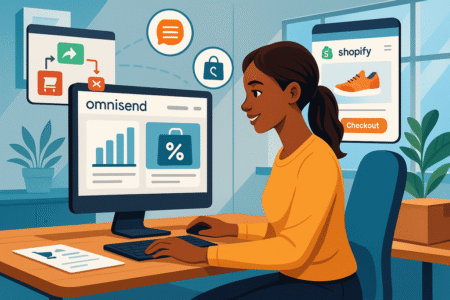
For online store owners, Omnisend is one of the best aweber alternatives because it was built specifically for ecommerce.
It goes beyond just sending emails — it connects directly with Shopify, WooCommerce, BigCommerce, and other store platforms to help you drive sales through automation.
SMS + Email Automation For Online Stores
Omnisend shines when you combine email with SMS. From the dashboard, if you click “Automations > Create Workflow,” you can design a sequence where a shopper first gets an email reminder, and if they don’t engage, they receive a personalized SMS.
Here’s how this plays out in practice:
- A customer abandons their cart.
- Omnisend sends a branded email reminder after 1 hour.
- If the cart is still abandoned, a discount code arrives via SMS the next day.
- The sequence ends with a follow-up email showing “best sellers” to re-engage them.
That layered approach increases conversion rates significantly. In fact, Omnisend has reported that businesses using SMS + email together see up to 47% higher conversion rates compared to email alone.
Pre-Built Workflows For Abandoned Carts And Sales
What I like about Omnisend is how it reduces setup headaches. Instead of building automations from scratch, you can choose from pre-built ecommerce workflows like:
- Abandoned cart recovery
- Welcome series for new customers
- Product review requests
- Post-purchase upsell sequences
Each one is fully customizable, but you don’t have to start with a blank slate. If you’ve ever wasted hours trying to piece together automations in Aweber, you’ll find this a breath of fresh air.
Shopify And WooCommerce Users’ Preferred Choice
Omnisend’s native integrations with Shopify and WooCommerce are what make it a favorite for ecommerce. You can sync customer data, product catalogs, and purchase history directly into your campaigns.
That means instead of sending generic emails, you can drop dynamic product recommendations right into your messages. For example, if someone bought a laptop, Omnisend can automatically recommend laptop bags or accessories in the next campaign.
For online stores that live and die by repeat purchases, Omnisend is one of the smartest aweber alternatives in 2025.
Benchmark Email: Simplicity Meets Affordability
Sometimes less really is more. Benchmark Email is a straightforward platform for small businesses that want something easy to use, affordable, and not bloated with unnecessary features.
If Aweber feels too dated and ActiveCampaign feels too advanced, Benchmark hits a comfortable middle ground.
Streamlined Features For Small Businesses
Benchmark’s interface is one of the cleanest I’ve used. From the dashboard, you can click “Emails > Create New Email” and you’re immediately guided through template selection, design, and sending without extra fluff.
This makes it ideal for small teams who don’t have hours to spend learning new software. You get:
- A drag-and-drop editor for emails
- Basic automation for things like welcome series or date-based triggers
- Contact management that’s simple but effective
It doesn’t overwhelm you with advanced CRM tools or multichannel options. It just focuses on getting campaigns out quickly and cleanly.
Competitive Pricing Compared To Aweber
Benchmark is also very cost-friendly. For lists up to 500 subscribers, it offers a free plan with unlimited emails — something Aweber doesn’t provide. Even at paid tiers, Benchmark typically undercuts Aweber while offering a smoother interface.
Here’s a quick price snapshot for 2,500 subscribers:
That’s not a life-changing difference, but for a small business, every dollar counts. Plus, you’re not sacrificing core features just to save a little cash.
When To Choose Benchmark Over Complex Platforms
Benchmark isn’t trying to be everything to everyone, and that’s its strength. If you’re a local business, a freelancer, or someone just starting out with email marketing, Benchmark keeps things easy and affordable.
On the flip side, if you know you’ll need advanced automations, deep integrations, or ecommerce-focused workflows, you may outgrow it. But for many businesses that just want reliable campaigns and basic automation, Benchmark is a better fit than both Aweber and heavier tools like ActiveCampaign.
Constant Contact: Reliable And Trusted Platform
Constant Contact has been around for decades, making it one of the most trusted names in email marketing.
It’s often recommended for small businesses, nonprofits, and organizations that value reliability and support over cutting-edge features.
Long-Standing Reputation In Email Marketing
When people look for aweber alternatives with proven track records, Constant Contact is always on the list. The platform has built its reputation on being dependable and offering strong customer support.
It’s particularly popular with nonprofits and local organizations because of its ease of use. From the dashboard, you can go to “Campaigns > Create” and quickly launch emails, event invites, or surveys without needing a steep learning curve.
Event Management Features Aweber Lacks
Here’s where Constant Contact stands out: event management. If you run workshops, fundraisers, or webinars, you can use Constant Contact to create event pages, send invites, track RSVPs, and follow up with attendees.
For example, a nonprofit could send out an event invite, collect registrations directly through Constant Contact, and then automatically send reminders to attendees leading up to the event. Aweber doesn’t offer anything close to this level of event functionality.
Where Constant Contact Fits Better Than Aweber
Constant Contact isn’t the cheapest or flashiest option, but it’s a great fit for organizations that prioritize support, ease of use, and event tools. Small businesses that host events, community groups, or nonprofits often find it more practical than Aweber.
If your email marketing is less about advanced ecommerce funnels and more about staying connected with a community, Constant Contact is one of the most reliable aweber alternatives out there.



